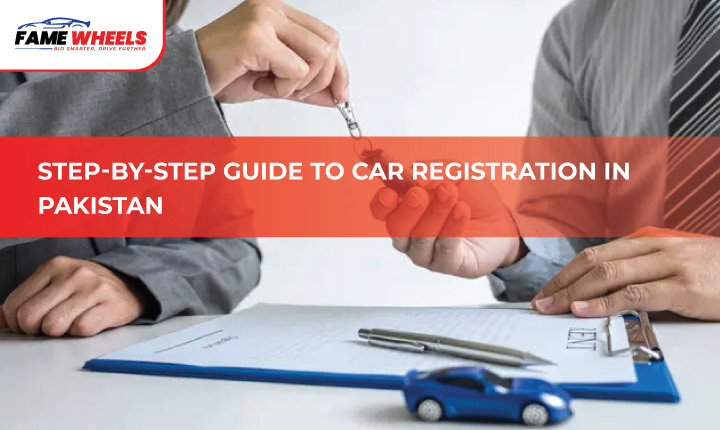Car registration in Pakistan is a necessary process that ensures your vehicle is legally recognized by the authorities. Whether you’re a new car owner or need to re-register your vehicle, understanding the steps involved can make the process smoother and more straightforward. Here’s a comprehensive guide of Car Registration by FameWheels, detailing everything you need to know:
Step 1: Price and Acquisition of the Vehicle
For New Cars
From Dealership: While buying a new car from a dealership company, you should be handed over different papers which comprise the sale invoice, delivery letter, manufacturer’s certificate and a CNIC.
For Used Cars
From Individual: They include the original car registration book, transfer letter signed by the individual from whom you are buying the car, a sale receipt and both buyer’s and seller’s CNIC photocopy.
Step 2: Get the Necessary Papers
You will need the following documents for Car Registration Process:
Sale Invoice: The bill of sale indicates that the seller or dealer is the car’s legal owner during the point of sale.
CNIC: A photocopy of a Computerized National Identity Card,
Proof of Address: Any bill or document that proves your residency.
NTN (National Tax Number): For commercial vehicles or if required.
Delivery Letter: This is offered by the dealership mainly with the new models of the cars for sale.
Manufacturer’s Certificate: For new cars, certification of vehicle manufacturing and its other specifications.
Registration Application Form: This can be collected from the concerned Excise and Taxation office or downloaded from their official website.
Vehicle Inspection Report: An car inspection report is especially for used car dealers.
Insurance Documents: Of all the provinces, you may not be required to insurance your car, but it is recommended that you do so.
Step 3: These are determined at the Excise and Taxation Office
Starting from the third level and above, documents required can be obtained from your local Excise and Taxation Office. The process is as follows:
Document Submission: All the necessary documents should be handed over to the concerned counter. It is also important for all relevant fields to be filled accurately so as not to cause a hold-up.
Verification: The documents will be processed by the officials. The documents will be processed by the officials. This involves verifying the CNIC number, sale invoice, and all relevant documents.
Payment of Fees: This means that you will have to part with some amount of money commonly referred to as the car registration fee which differs with the specific make or model of your car, the car engine size, and even the province in which you reside. It can be paid at the banks specified or at the E&T office solely where the holders are required to pay the fee.
Inspection: If you are to register a used car you will need to take your car for inspection by the Motor Vehicle Examiner in the state.
Token Tax: This is an annual tax that must be paid. In instances where you are registering, there might be other small taxes like the token tax that you will be expected to pay perhaps for the initial year of registration.
Step 4: Collection of Registration Plates and Documents
Once your documents are verified and the fees are paid, the E&T office will issue:
Registration Book: This is an official paper that will show that your car is registered. It includes such information as the engine number of your car, chassis number, and your details.
Registration Plates: It is issued by the E&T office and must be pinned on the vehicle as expected by the law of the country.
Token Tax Sticker: This sticker should be placed in a position where it can easily be seen, this is by placing it at the front of your windscreen.
Step 5: Ensure Compliance with Regulations
After car registration Process, ensure that you comply with the following regulations:
Display of Plates: Your car should have the issued number plates at the front and the rear. There shall be no branding that says custom plates.
Renewal of Token Tax: Always make your token tax renewal on an annual basis to be free from penalties.
Transfer of Ownership: There are some important steps if you want to sell your used car you have to do a legal transfer through the E&T office.
Conclusion
There are certain standard procedures and steps one has to follow while registering a car in Pakistan. Using the above guide, you will be able to understand the processes that the car registration will involve hence resulting in success. Whether you are registering a new or a used car, this article will help you in having the correct documents needed and knowing the stages that are required in the process.









